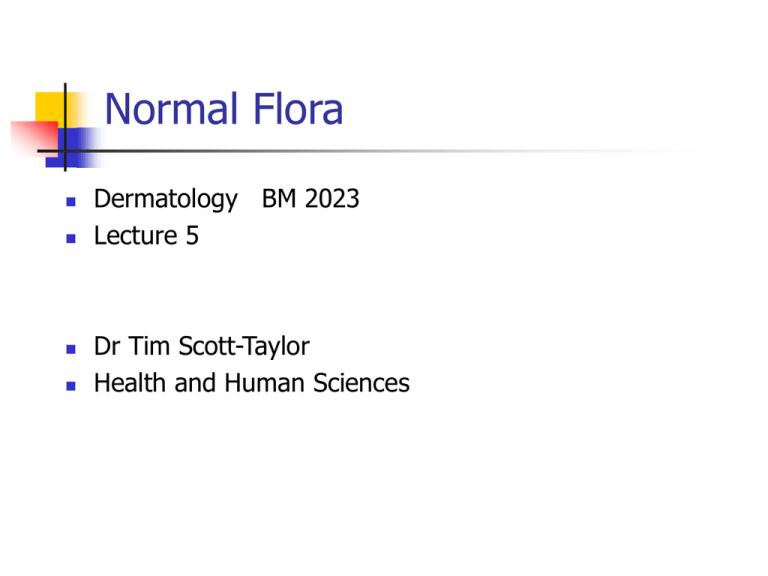
Normal Flora
Dermatology BM 2023
Lecture 5
Dr Tim Scott-Taylor
Health and Human Sciences
Topics
Information covered;
relations to host
significance of flora
position and density (various areas)
bacteria involved
benefits of bacterial flora
potential problems
Learning Objectives
Where normal flora comes from
Details of the prominent bacteria on skin
How they attach and where they reside
benefits of normal flora
Significant examples of opportunistic infections
Normal Flora
Present on all exposed skin
surfaces
Only tissues and certain
internal surfaces are sterile
Almost exclusively bacteria
(protozoa)
Usually benign, but potential
for opportunistic infection
Surfaces
Internal tissue:
eg blood, brain, muscle
normally free of microrganisms
Surface tissues: eg skin and mucus membranes
constantly in contact environment
readily colonised by some species
Internal mucosa: eg urethra, vagina, respiratory tract
low density specific organisms
The mixture of organisms regularly found at surface
anatomical sites is referred to as the normal flora or
microbiota
Microbes
Microbes; microscopic;
found in virtually
all environments
viruses
bacteria
fungi
parasites.
Man is surrounded by microbes.
Most of these are innocuous and are unlikely to pose
a major threat to animals.
saprophytes are harmless microbes that live on
inanimate material and derive their nutrition from
these environmental sources.
symbionts require a human or animal host to
survive and multiply. Symbiosis does not distinguish
between relationships that are harmful or beneficial
Symbiotic Relationships
Mutualism: two organisms from different species living in close
proximity to one another and relying on one another for nutrients,
protection or other life functions. Both organisms involved benefit from
the relationship.
Commensalism: two organisms from different species living in close
proximity to one another, in which one member is unaffected by the
relationship and the other benefits from it
Parasitism: two organisms from different species living in close
proximity to one another, in which one member depends on another for
its nutrients, protection or other life functions. The parasite benefits
from the relationship while the host is harmed by it
Amensalism: two organisms from different species living in close
proximity to one another, where one of the members suffers as a result
of the relationship while the other is unaffected by it
Commensalism
normal flora are commensals that derive food and shelter from
the host. They normally do no harm to the host. The host may
benefit from the presence of the microbe.
relationship also described as mutualism. No harm is done to the
host.
Commensal microbes colonise the host
Infection implies that harm is done to the host i.e. causes disease.
A microbe that causes disease is a pathogen.
Usually the host will manifest an inflammatory response to a
pathogen, but not to a coloniser at a normally non-sterile body site
Pathogen
a microbe that can initiate infection, often with only small numbers
strict pathogens i.e. will always cause disease
eg Bacillus anthracis (anthrax).
Some pathogens may sometimes almost behave like commensals,
eg Salmonella typhi (typhoid) (carrier state).
Whether a microbe behaves as a pathogen i.e. causes disease,
depends on the properties of the microbe and the host.
There can be a fine balance between microbial and host properties;
Immunity
Resistance
microbiota
Virulence
Disease
Nature of Normal Flora
A few Archaebacteria in the gut: Methanobrevibacter
smithii
Some prokaryotes, Candida albicans in mouth
Pneumocystis carinii in pharynx
Entamoeba gingivalis between teeth
Tooth Amoebas
Entamoeba gingivalis
microscopic parasites 10-35 μm
Live in crevices between teeth and gums.
Brushing does not remove them
Beneficial; eat mouth bacteria
only harmful when v. numerous
lack of oral hygiene
No cysts are formed; transmission is
entirely by oral-oral contact.
Nature of Normal Flora
A few Archeabacteria in the gut
Some prokaryotes, Candida albicans in mouth
Pneumocystis carinii in pharynx
Entamoeba gingivalis
But microbiota almost exclusively
bacterial
Numbers
Human body = ~1013 cells
Bacteria; 1010 in the mouth
1012 on the skin
1014 in intestine
Far in excess of
number of eukaryote
cells in all organs
Skin low density 100-1000s/cm2 ; except axillae
high moisture level groin
toe
Density varies; age
sex
diet
nutrition
Bacterial Staining
Bacteria distinguished primarily on
shape;
staining;
cocci / bacilli
gram +ve / -ve
Gram stain
Divides bacteria into
Gram positive – blue/purple
Gram negative- red
Hans Christian Gram,
Danish bacteriologist
devised stain in 1882
Gram Staining
Gram negative
Gram positive
Gram’s Stain Procedure
1.
2.
3.
4.
5.
6.
7.
8.
9.
10.
Place a slide with a bacterial smear on a staining rack.
Stain the slide with crystal violet for 1-2 min.
Pour off the stain.
Flood slide with Gram's iodine for 1-2 min.
Pour off the iodine.
Decolourize the slide briefly with acetone (2-3 seconds).
Wash slide thoroughly with water to remove the acetone
Flood slide with safranin counterstain for 2 min.
Wash with water.
Blot excess water and dry in hand over bunsen flame.
How Does it Work?
Gram didn't know - he simply worked
empirically
Gram reaction is based on the
structure of the bacterial cell wall
In Gram-positive bacteria, the purple
crystal violet stain is trapped by the
layer of peptidoglycan which forms the
outer layer of the cell
• In Gram-negative bacteria, the outer membrane prevents the stain
from reaching the peptidoglycan layer in the periplasm. The outer
membrane is then permeabilized by acetone treatment, and the pink
safranin counterstain is trapped by the peptidoglycan layer.
Bacterial Cell Walls
Lipoteichoic acids traversing wall
and anchored in basement
membrane
Bacterial cell walls
polysaccharide
(O antigen)
porin
lLipid A
cell wall
lipoprotein
peptidoglycan
Lipid bilayer plasma membrane
with integral proteins
Gram-positive
Lipid bilayer plasma membrane with
integral proteins
Gram-negative
Four Basic Types
Gram + cocci
e.g. Staphylococcus aureus
Gram + rod
e.g. Bacillus cereus
Gram - cocci
e.g. Neisseria
Gram - rod
e.g. Escherichia coli
Bacterial Shape
Common Bacteria in Flora
BACTERIUM
Skin
Eye
Nose
Mouth
Intestine
Urethra
Vagina
Staphylococcus epidermidis
Staphylococcus aureus*
Corynebacteria
Mycobacteria
Streptococcus pyogenes*
Streptococcus pneumoniae*
Neisseria sp.
Haemophilus influenzae*
Escherichia coli *
Streptococcus mitis
Streptococcus salivarius
Streptococcus mutans*
Enterococcus faecalis*
Bifidobacterium bifidum
Lactobacillus sp.
++
+
++
+
+/-
+
+/+
++
+
++
+/-
++
+
+
+
++
+
+
+/-
++
+/+
+
++
+
+
++ = nearly 100 percent
+/+/+
+/+/-
+/+
+
+/-
+
+
+
+
+
++
++
++
+
++
+ = common
+/- = rare
+
+/+/+
++
+/-
+
+
+
+
++
++
++
+
+
* = potential pathogen
++
Specific Organisms
Skin surfaces
staphylococci, corynebacteria and streptococci
Oral cavity
streptococci, staphylococci, corynebacteria,
anaerobic organisms, yeast (fungi)
Large bowel
anaerobic bacteria e.g. Bacteroides sp., a number
of coliforms e.g. Escherichia coli, and faecal
streptococci e.g. Enterococcus sp.
Nose
staphylococci, streptococci, corynebacteria
Nasopharynx & upper resp.
tract
streptococci, staphylococci, corynebacteria,
Neisseria sp.
Vagina
Lactobacillus sp, Bacteroides sp, Enterococcus sp.
Skin
Not a great habitat; dries out, constantly being shed,
secretions include fatty acids (lower pH to 4-6) and salt.
Some skin regions better habitats than others: scalp,
ears, underarms, anal region are all especially good
Bacteria that can grow on skin must be able to survive
these conditions.
Typical bacteria: Staphylococcus epidermidis, not
normally a pathogen: but infection via surgical implants
and catheters
Propionobacterium acnes; lives in sweat glands, hair
follicles, not eliminated by washing skin.
Staphylococci
Gram positive cocci in clusters
• Greek staphyle = bunch of grapes
• S. aureus :
cause of soft tissue infections
coagulase test toxic shock syndrome (TSS)
clot plasma
scalded skin syndrome.
• S. epidermidis : common on skin, coagulase-negative
Corynebacteria
Gram positive rod
(bacillus)
Pallisades
Chinese writing
•
•
•
•
common on skin and in GI tract
irregular pleomorphic with metachromatic granules
grey / black colonies on tellurite medium
C. diphtheriae throat pathogen potent toxin
Streptococci
Gram positive cocci in chains
• Streptococci occur on all skin and mucosal surfaces
• glycocalyx: adherence to plastic and cells
resistance to phagocytosis and antibiotics.
• Streptococcus pyogenes common on skin but causes
erysipelas, scarlet fever, rheumatic fever
Conjunctiva
Not completely sterile, numbers of bacteria is small
Lachrymal secretions contain lysozyme
Blinking continually wipes away bacteria
Staphylococcus epidermidis
Corynebacteria
Blepheritis
Conjunctivitis
Specific attachment to receptors
sialic acid residues
dominant
Haemophilus
Chlamydia
Respiratory Tract
Nares (nostrils) are heavily colonised > 200 species
Staphylococcus epidermidis
Corynebacteria
dominant
Staphylococcus aureus (20% of population)
Upper respiratory tract
most non-pathogenic
but some pathogens
Lower respiratory tract
also highly colonised
non-haemolytic Streptococci
Neisseria
Streptococcus pneumoniae
Haemophilus influenzae
Mucus
action of cilia
tissue damage
disease
Urogenital Tract
Upper urogenital tract;
normally sterile
action of urine
Anterior urogenital tract;
Vagina;
Corynebacteria
Staphylococci
Streptococci
Staphylcoccus epidermidis
Escherichia coli
Colonise soon
after birth
Lactobacillus acidophilus:
bacteria
at puberty
lactic acid
prevents establishment other
Mouth
Favourable habitat;
nutrients and secretions
epithelial debris
lysozyme
saliva 104-109/ml organisms
Streptococcus salivarious ; 98% predominant
until teeth erupt
Flora increasingly complex, anerobes, Bacteroides
Streptococcus mutans
Streptococcus sanguis
Streptococcus pyogenes
Dominant, caries
rheumatic fever
damaged heart valves
Dental Caries
Initiated by normal flora, Streptococcus mutans
Dental plaque; consists 60-70% cells
salivary polymers
bacterial extracelular products
Initiated by glucosyl transferase, surface enzyme
initial attachment to tooth via salivary glycoprotein
creation of glycan biofilm = bacterial capsule
lactic acid from dietary sugars demineralises enamel
Lactobacilli
secondary invaders
Actinomyces israelli
proteolytic
Normal Gut Flora
relatively few bacteria
in anterior bowel
increasing diversity and
density of bacteria in
posterior bowel
Escherichia coli
Gram negative rods (bacilli)
• type faecal bacterium (enterococus in US)
• opportunistic pathogen in urogenital canal
• E. coli 0157: haemorrhagic colitis, uncooked meat
GI Tract
digestive enzymes and stomach acid kill bacteria
small intestine has few bacteria, colon huge population
1/3 of faeces is bacteria
up to 1000 organisms/gram
over 300 different species
E. coli is only 0.1% of total population
anaerobic Bacteroides most abundant; ~ 25% microbiota
bacteria in colon divide every 12-24 hours on average,
much slower than laboratory batch culture rates.
GI Tract
high flow rates make small intestine difficult to colonize,
concentration of bacteria remains low, ~106/ml
takes food ~3-5 hours to move through small intestine
takes food 24-48 hours to travel through the colon
slow flow rates allow bacterial multiplication, 1012-1013/ml
30-50% of contents, ~2-3 lbs weight = bacteria
bacteria breakdown complex polysaccharide; xylan
cellulose
called colonic fermentation
pectin
colon an organ of digestion where normal flora does most
of the work
Tissue Tropism
Normal flora exhibit a tissue predilection for colonisation
Could be due to;
- supply of a specific essential
growth factor
- construction of a biofilm
some bacteria are able to colonise the biofilms of
others, most biuofilms are a mixture of bacteria
- a specific receptor
present at some sites
Examples of Tissue Tropism
BACTERIUM
TISSUE
Staphylococcus epidermidis
Skin
Staphylococcus aureus
Nasal membranes
Streptococcus pyogenes
Throat
Neisseria gonorrhoeae
Urogenital epithelium
Streptococcus mutans
Tooth surfaces
Streptococcus salivarius
Tongue surfaces
Vibrio cholerae
Small intestine epithelium
Escherichia coli
Small intestine epithelium
For some of bacteria in normal flora the
attachment factors are precisely known
Attachment Factors
BACTERIUM
BACTERIAL
LIGAND
TISSUE
RECEPTOR
ATTACHMENT
SITE
Streptococcus
pyogenes
Protein F
fibronectin
Pharyngeal epithelium
Streptococcus
mutans
Glycosyl transferase
Salivary glycoprotein
Pellicle of tooth
Streptococcus
salivarius
Lipoteichoic acid
Unknown
tongue epithelium
Staphylococcus
aureus
Cell-bound protein
fibronectin
Mucosal epithelium
Neisseria
gonorrhoeae
Methyl- alanine pili
Glucosamine-galactose
cervical epithelium
Escherichia
coli
Type-1 fimbriae
mannose
Intestinal epithelium
Vibrio cholerae
Methyl-alanine pili
Fucose and mannose
Intestinal epithelium
Gnotobiotic Animals
Germfree, axenic; to study effect of normal flora
easy to produce germfree birds; sterilize shell, use sterile incubator
Germfree mammals;
cesarean section
isolation chambers
air, food, water sterilized
Germfree animals are less healthy than animals with normal flora;
Greater vitamin requirements for K and B complex
lower cardiac output
much more susceptible to pathogens
much smaller infectious dose required to initiate an infection
Live shorter lives
Benefits of Normal Flora
Synthesise and secrete vitamins;
vitamin K
germ-free deficient
vitamin B12
Prevent colonisation by pathogens
oral cavity, skin
germ free 10 salmonella vs 106
gut
lactobacilli maintain high pH
vagina
Antagonise other bacteria;
fatty acids
inhibit / kill
peroxide
bacteriocins
Stimulate certain tissues;
Peyer’s patches
poorly developed immune system
caecum
Stimulate cross-reactive antibody
immunise against pathogens
Disadvantages of Normal Flora
1. Body odour
body odour originates from the skin
decoposition of secretions of apocrine sweat glands
located primarily under arms and in the groin
Corynebacterium tenuis and C. xerosis in particular
best eliminated through good hygiene
fungal infections such as athlete's foot also odourous
Antibiotic Resistance
MRSA: Methicillin Resistant Staphylococcus aureus
resistant to all commercially available antibiotics,
including methicillin and vancomycin
carried in the noses of health care workers and
transmitted from patient to patient
major cause of surgical wounds and systemic infections
antibiotic resistance is transferred to other organisms
recent NHS directive to alcohol wash hands between
beds has cut incidence by 50%
Opportunistic Infection
Some commensals can act as pathogens when host’s
defences are weakened or immunocompromised
infection caused by a normally benign commensal
eg infection with Candida albicans (yeast)
a normal commensal of mouth and gut
in immunosuppressed leukaemia patients
eg infection with Pneumocystis carinii
a low virulence fungus
during mmunosuppresion due to HIV
Opportunistic Infection
Some organisms that are commensals at one body site
may be pathogens at another body site
eg Staphylococcus aureus in the nose (commensal)
in a post-operative wound infection (pathogen)
eg Escherichia coli in GI tract (commensal)
in urinary tract causes UTI (pathogen).
Dental Caries
Teeth in skulls from Europeans prior to the 1500's
showed remarkably well-preserved teeth.
Once sucrose, a dissacharide from cane sugar, was
introduced tooth decay became widespread
S. mutans produces a thick
capsule of dextran. The gooey
polysaccharide forms a biofilm and
allows other bacteria to attach
Dental Plaque accumulates
S. mutans uses lactic acid fermentation exclusively as
its catabolic pathway. Acids attack tooth enamel
Ulcers
Stomach acid attacks duodenal lining; ulcers related to
stress;
1980s Warren and Marshall discovered antibiotics
reduced ulceration, awarded Nobel Prize Medicine 2005
30-50% of human population carry Helicobacter pylori
Spiral shape and flagella helps bacterium burrow into
protective mucous lining. Enzyme urease converts urea
into ammonia and bicarbonate, neutralizes stomach acid
ammonia
protease
toxic to duodenal epithelial cells
catalase
phospholipases
H. pylori and Gastric cancer
bacterium categorized as
group I carcinogen by the
International Agency for
Research on Cancer (IARC)
Gastric carcinoma
MALT lymphoma (mucosa
associated lymphoid tissue
associated with H. pylori
Two related mechanisms proposed;
1. free radicals production increases rate of cell mutation
2. TNFα, interleukin 6, inflammation alter cell adhesion
proteins and mutate tumor suppressor genes
Summary
Bacteria perform physiological, nutritional and protective
functions in the human body.
Maintaining a balance is crucial
Flora consists of ecosystems
consequences of disruption
unpredictable.
antibiotics
tissue damage
medical procedures
changes in diet
normal flora is complexity and understanding of function
limited eg < 1% of bacteria grow on laboratory media
> 99% the microbial world unexplored










